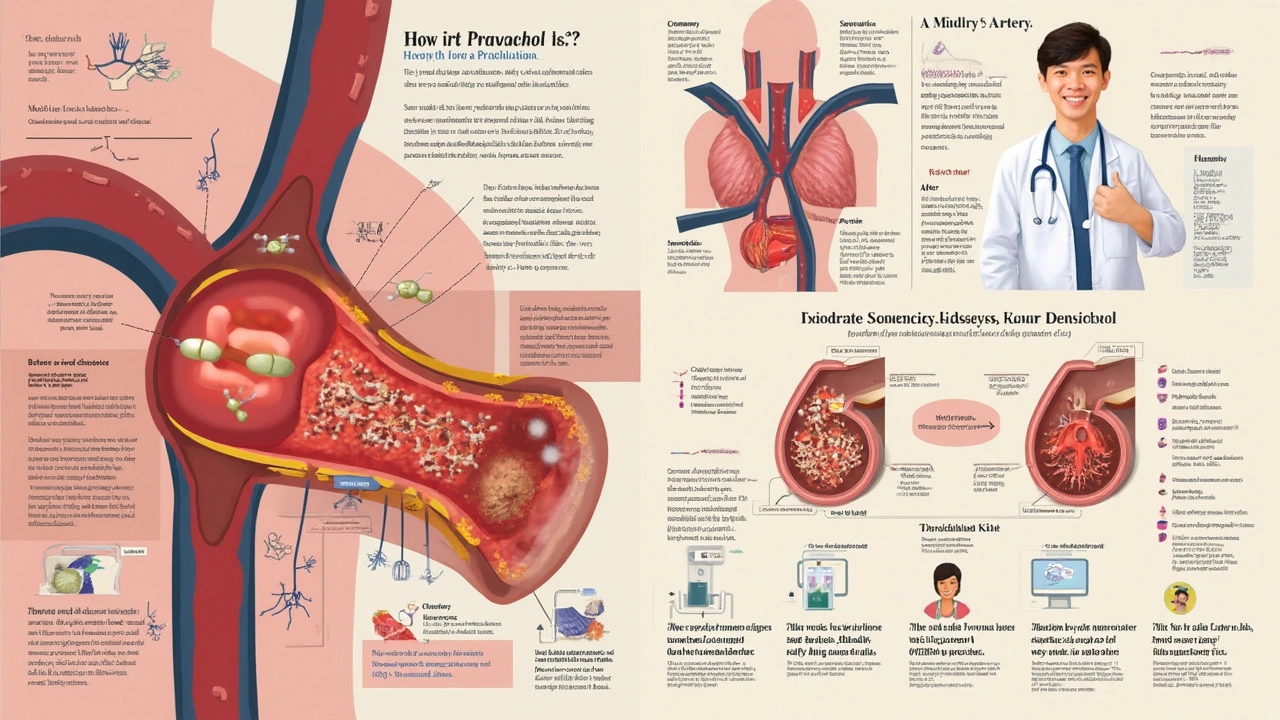Pravachol: Cholesterol Medication Uses, Side Effects, and Guidance
 Jun, 26 2025
Jun, 26 2025
It’s a little unnerving to open your lab results and spot that little red arrow next to your cholesterol reading. Suddenly, your heart’s got your attention. "Cholesterol medication?" the doctor says, and maybe you picture pill organizers and a family history you can’t outrun. Pravachol, known in the medical world as Pravastatin, isn’t the newest name on the market, but it’s everywhere. This statin has been prescribed for decades, and it’s helped millions bring their cholesterol in check. But what’s actually going on in your body when Pravachol enters the scene? Why do some swear by it while others get tired of the word "statin"? Let’s unpack what makes this white, oblong tablet the linchpin in so many medicine cabinets — and whether it’s right for you.
How Pravachol Works: A Nuts-and-Bolts Look at Statins
Understanding Pravachol starts with one word: statin. Statins are designed to lower your LDL (that’s the so-called "bad" cholesterol), reduce your risk of heart attack, and help you sidestep trouble down the line. Pravachol does this by targeting an enzyme in your liver called HMG-CoA reductase. Think of this enzyme as the main ingredient supplier in the cholesterol factory inside your body. Pravachol tells that enzyme, "Hey, take a break," and your body ends up making less cholesterol. Your liver then works overtime to suck more cholesterol out of your bloodstream. Over time, this leads to lower LDL levels, while also sometimes nudging your HDL (the "good" cholesterol) up a notch.
Why do doctors lean on Pravachol? Well, for one thing, it’s been around since the early 1990s, so researchers have mountains of data on it. That’s not just comforting, it’s helpful. For most folks, Pravachol can slash LDL cholesterol by about 20% to 34% depending on the dose. And those drops are no small potatoes: Studies published in journals like the New England Journal of Medicine have tied lower LDL levels from statins like Pravachol straight to fewer heart attacks and strokes.
But Pravachol is a little different from its statin cousins. It’s known for a lower chance of causing muscle aches and for not messing much with drug interactions. People who can't tolerate statins like Atorvastatin or Simvastatin often find Pravachol easier on their body. It also doesn’t hit your liver quite as hard as some other statins, so doctors tend to offer it to folks with a higher chance of liver side effects from medication.
For those worried about genetics, it turns out certain people are "high absorbers" of cholesterol and statins help even more here. Pravachol can also be paired safely with other medicines, which is huge if you’re juggling a few prescriptions — a common story if you’re over 50.
Here’s the part where the numbers speak louder than words. Check out how Pravachol impacts your cholesterol levels and your risk of heart incidents:
| Dosage (mg/day) | Approx. LDL Reduction | Recent Study: Heart Event Reduction |
|---|---|---|
| 10 | ~20% | ~19% |
| 20 | ~24% | ~22% |
| 40 | ~34% | ~27% |
Don’t forget that statins do more than bust bad cholesterol. They stabilize the fatty plaques hanging out in your arteries, which makes heart attacks less likely. Even folks with average cholesterol readings but a family history of heart disease might get a boost from Pravachol. Cardiologists sometimes call this the "statin effect," where lowering inflammation and giving arteries a break helps you dodge bigger health scares down the road.
Wondering if food and lifestyle still matter? Definitely. Statins aren’t a free pass to pound cheeseburgers — your best shot at dodging heart disease is mixing medication with diet tweaks. Doctors love to talk about the Mediterranean diet for a reason.

Who Gets Prescribed Pravachol—and What to Expect From Side Effects
So, who ends up with that prescription? Truth is, it’s not just folks with sky-high cholesterol getting Pravachol. If you already had a heart attack or stroke, or you have diabetes plus other heart risks, your doctor’s probably reaching for that prescription pad. Even if your numbers are just slightly above target, a family history of early heart trouble can put you in Pravachol territory, too.
Doctors also size up your personal risk using calculators like the ASCVD Risk Calculator. That means they weigh stuff like your age, cholesterol numbers, blood pressure, smoking status, and whether you’re diabetic. A coronary calcium scan or carotid ultrasound might nudge a hesitant physician toward starting a statin, especially if your artery walls look a bit sketchy on those images. Guidelines from American Heart Association have tightened since 2018: more folks are now told to at least consider a statin if their risk score tips past 7.5% in 10 years.
Here’s where questions pop up: What side effects should I watch out for? Side effects from Pravachol are usually mild, but about 5% to 10% of people feel muscle aches, tiredness, or cramps in the early weeks. Sometimes it’s mild enough to ignore, or it goes away after your body gets used to the drug. Rarely, you might see dark pee, yellow eyes, or profound weakness — those call for seeing your doctor fast, as they could signal trouble with your liver or muscle breakdown (rhabdomyolysis).
A few folks feel more forgetful on statins, but larger studies haven’t found strong evidence that Pravachol causes real memory loss. If any odd symptoms crop up, it’s worth flagging for your doctor, but don’t panic. Testing your liver enzymes is standard before starting Pravachol and sometimes a few months into treatment. After that, most people don’t need more testing unless symptoms pop up. If muscle pains get annoying, sometimes doctors suggest taking a break, lowering your dose, or switching to a different statin or dosing every other day.
These tips make life with Pravachol smoother:
- Take Pravachol once daily, usually at bedtime, since your liver makes more cholesterol overnight.
- If you skip a dose, don’t double up — just get back on schedule the next day.
- Mixing Pravachol with grapefruit juice isn’t dangerous (unlike with other statins), but keep moderation in mind if you have any liver issues.
- Watch for any muscle pain that gets worse over days.
- Report dark urine, skin or eye yellowing, or extreme fatigue right away.
- Stick to checkups — retesting cholesterol every few months helps your doctor make sure you’re getting the benefit.
Pravachol's safety for different age groups gets solid marks. In seniors, it’s less likely to trigger muscle issues compared to other statins. It’s one of the go-to options for people with mild-to-moderate kidney problems, too, since it’s handled by the gut and kidneys and doesn't build up dangerously.
Worried about drug interactions? Good news: Pravachol doesn’t play rough with blood thinners, most antibiotics, or heart rhythm drugs. If you’re on meds like cyclosporine or some HIV treatments, your doctor might suggest a different statin, but most people don’t need to worry. Even people on thyroid medications or antidepressants can usually have Pravachol without a hitch.

Real-World Tips: Maximizing Pravachol’s Benefits and Keeping Risks Low
Here’s where real-world wisdom kicks in. Folks who get the most out of Pravachol aren’t just swallowing a pill and hoping for miracles. They’re also making little tweaks that stack up over time. For starters, consistency is huge — skipping doses drops Pravachol’s effectiveness and messes with your numbers. Even popping your pill at the same time each day helps set your routine and makes it harder to forget.
Diet matters more than you might guess. Studies from places like Harvard show that folks who switched to a high-fiber, low-saturated fat diet alongside Pravachol dropped their cholesterol on average 7–15% more than people who just relied on pills alone. Toss in some daily walking or jogging, and your numbers practically beg for mercy. If you’re worried about boring meals, season things up with herbs or try whole-grain swaps — it doesn’t take a gourmet chef to make heart-healthy food taste good.
Here’s a checklist for getting the most from Pravachol:
- Check your cholesterol every 3–6 months, especially in the first year.
- Keep up with dentist visits—studies say gum disease makes heart disease worse, so healthier gums help the statin work better!
- If you get muscle aches, ask your doctor about coenzyme Q10 supplements—some small studies say it helps reduce this side effect.
- Drink enough water, especially if you’re physically active. Staying hydrated can help with muscle cramps.
- If your doctor suggests other meds for blood pressure or diabetes, using them with Pravachol can dial down your heart risk far more than using statins alone.
People with genetic high cholesterol (familial hypercholesterolemia) might take higher doses or combine Pravachol with other meds like ezetimibe. Rarely, when cholesterol just won’t budge, doctors look at new injectables, but Pravachol remains the starter for most cases.
Some folks ask, "Can I ever stop?" Usually, Pravachol is a lifelong companion, but if cholesterol stays low for years, your lifestyle is rock solid, and you have no other risk factors, your doctor might consider lowering your dose or spacing out refills. But stopping cold turkey means numbers creep up again, and the heart risks come right back. The stakes are real—according to CDC data from 2022, cardiovascular disease remains the leading cause of death in the U.S., and statins are credited with preventing tens of thousands of heart attacks each year.
One last thing: don’t sweat every minor bump if you’re on Pravachol. A pizza here, a lazy day there — that’s real life. It’s the pattern that counts, not the perfection. Trust your doctor, keep tabs on how you feel, and treat Pravachol like a partner rather than just a prescription. Chances are, it’ll go a long way toward keeping your ticker strong.
Max Rogers
July 18, 2025 AT 18:03This post gave me a pretty clear overview of Pravachol and its uses, thanks for sharing!
Cholesterol meds always seem a bit daunting because of the side effects and the lifelong commitment, but knowing how Pravastatin works to reduce LDL cholesterol by inhibiting the HMG-CoA reductase enzyme helps put things in perspective.
It’s really important to remember that while it can lower cholesterol levels, lifestyle changes should go hand-in-hand with medication for the best results.
One thing I'd add is to keep an eye out for muscle pain or weakness, which can sometimes be a sign to check in with your doctor.
Also, timing and dietary considerations (like avoiding grapefruit juice) can enhance how well Pravachol works.
Thanks again for the detailed guidance — knowledge is power when managing heart health!
Jonathan Mbulakey
July 20, 2025 AT 00:58Honestly, the paradox of medication like Pravachol is intriguing. We’re relying on a chemical intervention to mitigate the risks posed by how we live and eat.
It’s a sort of philosophical conundrum — should we simply accept these medications as part of modern living, or push greater changes at the root causes instead?
The balance strikes me as delicate, though anything that helps prevent serious cardiovascular disease carries value.
Pravastatin’s side effects seem nuanced; it’s comforting that people tend to tolerate it well, but there’s always that lingering contemplation about long-term impacts on the body.
Thanks for the deep dive — gives one a lot to chew on beyond just popping a pill.
Deborah Escobedo
July 21, 2025 AT 11:01This is super helpful for anyone starting Pravachol and feeling worried about side effects.
It's great that you included practical tips alongside the medical information, because understanding the why and how makes the whole process less intimidating.
Some people fear the unknown more than the actual symptoms, so knowing to watch for muscle pain, keep hydrated, and inform your doctor if anything unusual occurs is crucial.
Remember, cholesterol meds aren’t magic bullets; they work best combined with a heart-healthy diet and regular exercise.
Stay positive and keep open communication with your healthcare provider — that’s the real key to success here.
Dipankar Kumar Mitra
July 22, 2025 AT 22:05Not to sound harsh but sometimes people put way too much faith in medications like Pravachol without really owning up to personal responsibility.
Sure, it lowers cholesterol, but there’s no excuse to keep gorging on junk food expecting the drug to fix everything.
Side effects? Yeah, they suck sometimes, but they’re part of the territory when messing with body chemistry.
You gotta be proactive with your health; taking the pill is only half the battle.
If you’re not willing to make lifestyle changes, why bother with meds at all? Just my two cents but practicality matters.
Tracy Daniels
July 24, 2025 AT 08:18💡 Really appreciate the clear explanation on how Pravachol functions to reduce cholesterol! It can be quite overwhelming to start a new medication.
😊 Just a reminder to folks out there: always be consistent with taking your meds and attend regular check-ups to monitor how things are going.
💊 Also, don’t hesitate to report any side effects like unexplained muscle pain to your doctor promptly!
🙌 Combining this medication with healthy habits like balanced diet and moderate exercise is the best approach to improve cardiovascular health.
Sending good vibes to everyone managing their heart health journey! ❤️
Jean-Sébastien Dufresne
July 25, 2025 AT 18:23Oh come on!! Pravachol? The only real solution is a strict Canadian diet and regular hockey! 🍁
This medication might lower cholesterol temporarily, but unless you're pairing it with rigorous exercise and observing your nutrition carefully, it’s useless.
I see way too many people relying on pills while still devouring greasy food like poutine every day!
Let's stop making excuses and start putting in the actual work; that's how we protect our beautiful maples and hearts!
👏👏 Let’s go Canada, eh!
Patrick Nguyen
July 27, 2025 AT 04:36Pravachol’s pharmacological action is fairly well established in the literature, predominantly through competitive inhibition of HMG-CoA reductase.
This effectively decreases endogenous cholesterol synthesis in hepatic cells, which subsequently lowers plasma LDL concentrations.
An important clinical caveat, however, involves careful monitoring for rare but serious adverse effects such as rhabdomyolysis.
Moreover, the timing of administration in relation to circadian variations of cholesterol biosynthesis is sometimes overlooked.
While not extensively used, evening dosing might yield marginal benefit according to some studies.
Nonetheless, patient education remains paramount to ensure compliance and early detection of side effects.
Fiona Doherty
July 28, 2025 AT 14:50This post feels a bit too optimistic about side effects.
Truth be told, a lot of people I know complained about muscle cramps and fatigue which they didn't anticipate at all.
Doctors sometimes gloss over the worst case scenarios, and that’s frustrating.
It’s not just ‘a little muscle pain’; for some it's debilitating and leads them to stop medication altogether.
People deserve a more realistic picture, and alternatives if Pravachol isn’t tolerated well.
Neil Greer
July 30, 2025 AT 01:05Ah yeah, I’ve been on Pravachol for a few years now and honestly, the side effects were minimal for me.
Just had some slight muscle aches here and there but nothing that stopped me from working out or doing stuff I enjoy.
Also, I found taking the pill in the evening helped, like others pointed out.
Diet wise, cutting back on fried foods helped loads alongside the medication.
Overall, definitely recommend following doc’s advice strictly and monitoring your health regularly.
Not a cure all but a great aid in managing cholesterol.
Fionnuala O'Connor
July 31, 2025 AT 11:20Don’t forget the importance of consistency when taking Pravachol.
Skipping doses or stopping medication abruptly can have serious consequences for cholesterol control.
Also, always inform your healthcare provider if you’re taking other medications or supplements to avoid interactions.
Keep track of any new symptoms, even those you think might not be related.
A proactive approach makes a big difference in managing your heart health effectively.
Christopher MORRISSEY
August 17, 2025 AT 06:06It is pertinent to consider the socio-cultural implications of depending heavily upon pharmacological agents such as Pravachol in the contemporary era.
While this statin effectively attenuates low-density lipoprotein cholesterol through enzymatic inhibition, the broader questions about lifestyle adaptation and healthcare accessibility remain pivotal.
Moreover, patients must be cognizant of the side effect profile — muscle pain, hepatic enzyme elevations, and the potential necessity for periodic laboratory evaluations.
The alignment of medication adherence with ongoing dietary and physical activity modifications cannot be overstated.
Such a comprehensive approach embodies the holistic care model, ensuring not only clinical efficacy but also improved quality of life.